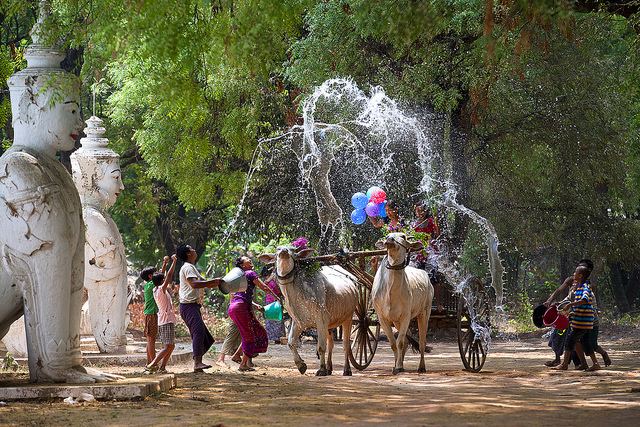Water Festival
Being a happy-go-lucky people, Myanmars hold several festivals in a year. In the days of Myanmar Kings, there was a major festival in every month of year even though some of them have ceased to be celebrated, there must be dozens of them left, various pagoda festivals and other regional ones which are held all over the country. Thus, our country is a veritable land of festivals being the land of Pagodas. The merriest among them is Thingyan, the Water Festival. The Thingyan Festival marks the changing of the old year to the new. In other words, Thingyan is the Myanmar New Year Festival. It is usually falls on 13th April and last for three or four days. Customarily, children usher it in a day advance. The main feature of the festival is water-throwing or pouring water. Anyone can throw water at or pour water on anyone else with impunity during the festival.
However, throwing water at elderly people, pregnant women and Sabbath-keepers is taboo in rural areas. Public servants on duty such as policeman and postmen are also exempted from being doused. As a rule, people take no offense when they are doused because water throwing is a deep-rooted custom. The only thing is water throwers are expected to use clean pure water. There are three reasons for pouring or throwing water during Thingyan. Firstly, it is done as a symbol of washingaway the impurities or sins of the old year; the second reason is that; water throwing relieves the intense heat of April which is the hottest month of the year. No wonder most people welcome it on one seems to mind it. The third reason is simply to have fun. In the village, children throw water squirts made of bamboo, tin or plastic. Some people even use buckets for a hearty dousing. In towns, water-throwing hoses are used. The use of the fire-hoses and water balls made of plastic are banned as being dangerous. During Thingyan Festival water-throwers use to make fun by teasing one another to their hearts content. But no one seems to mind and peace and friendliness prevail throughout the festival. Some people erect water-throwing pedals at the road-side and throwing water at the passing cars and passerby. Some go round the town in cars receive water-throwing. Special interest of Thingyan is beautiful decorated cars featuring big boats go round the city entertainingthe people, singing dancing and Thangyat chanting. Thingyan is not only a time of fun but also a reason of good will and good deeds. Elderly people spend the days observing Sabbath, listening to sermons at monasteries; and it is the time for washing the Buddha’s image in the family shrine room with scented water.
Some young men are receiving into the holy older of the yellow Robe to become temporary monks around the time of the festival. Some young women earn merit by attending to the needs of the elder ones, such as feeding, washing the hair and nail clipping. Thingyan is also a time for communal feeding, the most popular seasonal food being jaggery-center-dough-ball that floats on water (Mon-Lon-Ye-Paw in Myanmar term). As a rule, it is communally made and distributed in the neighborhood and fed to all passersby. Thingyan is also a time for novice ceremonies. Many young people are busy with their songs, music, dancing and thangyat for the festival when nearing the time of Thingyan, there is the flowering at the gumkino-trees (Padaut trees) that occurs only three times in a year, lasting for only one day each time. Water-throwing and prize-giving pandals mushrooming overnight everywhere just before the festival begins. In Yangon, Thingyan Festival is held by erecting a big pandal just in front of the Town Hall sponsored by Yangon YCDC (Yangon City Development Committee) and there are also traditional dancer and music playing merrily on the stage every year. It is also one of the highlights in Yangon during Thingyan Period. The festival falls on 13th to 16th April annually.


